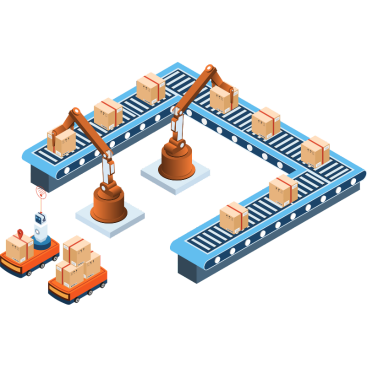In the dynamic ecosystem of PALMS™ Smart WMS integrated with an ERP (Enterprise Resource Planning) system, a plethora of vital information is exchanged seamlessly. Augmenting operational efficiency with the shared data, internal processes are further optimized and ultimately the customer experience is smoother.
The data sync from PALMS to ERP ensures that your ERP tool has all the up-to-date information on inventory levels and movement within the warehouse.
PALMS is a warehouse management software used by large enterprises worldwide. Without a direct integration with ERP, updating sales and customer data alongside the inventory data becomes a time-consuming and cumbersome task. This can lead to incongruencies, for example, the online store may continue taking orders for items that are out of stock.

The ERP and WMS maintain a continuous exchange of information, and their roles evolve based on data types and processes, resembling the well-known master/slave IT model. This establishes a data stream in both directions:
Stringent control of this data exchange is crucial to prevent errors and duplication. This control is typically implemented through assigning various statuses (pending, processing, prepared, loaded, dispatched, etc.), guiding both systems on permissible actions based on defined rules. For instance, the WMS is restricted from loading orders not marked as “invoiced” by the ERP.
On a technical level, there are various ways to carry out the data exchange between the ERP and WMS. Let’s look at the various ways PALMS achieves this integration:
Staging tables are intermediary tables specifically designed to hold the extracted data temporarily. These tables act as a buffer zone, allowing data to be transformed and validated before being sent to the ERP system. The ERP system periodically retrieves data from the staging tables. Integration tools or scripts are employed to map the data from the staging tables to the corresponding tables or modules in the ERP system.
Data extracted from the WMS is transformed into a format that is suitable for flat file representation, often CSV format. Data may be restructured, reformatted, or modified to match the requirements of the ERP system. The CSV files are transferred from the WMS system to the ERP system. This transfer can occur through various means, such as file transfer protocols (FTP), secure file transfer protocols (SFTP), or other designated communication channels.
In this case, the exchange of information between the ERP and WMS is done through a web interface, so both systems need to have internet access to be able to operate with it. This means that the software programs call a database in the cloud via HTTP protocol. The database then returns the information in XML format, which is subsequently incorporated into the system.
Transparency is key in the modern business landscape. The integration allows customers to track their orders effortlessly. From order placement to shipment and delivery, real-time updates are made available, providing customers with a heightened sense of control over their purchases.
Armed with a 360-degree view of customer interactions, your team can provide personalized and responsive service. Integrated systems enable your customer service representatives to access order history, preferences, and issues, allowing them to address customer inquiries swiftly and effectively.
Integration facilitates accurate demand forecasting by combining sales data from ERP with inventory insights from WMS. This not only helps in maintaining optimal stock levels but also allows customers to know product availability in advance, fostering trust and loyalty.
The billing process can be streamlined with automated data exchange between WMS and ERP. Invoices are generated accurately based on fulfilled orders, reducing billing errors and ensuring that customers are billed correctly and promptly.
Simplify the returns process by integrating data seamlessly. When a customer initiates a return, the information is relayed between WMS and ERP, expediting the processing of returns and refunds. This efficiency enhances the overall customer experience, turning a potentially frustrating situation into a positive interaction.
Unlock efficiency, enhance customer satisfaction, and propel your business into the future. Embrace the power of seamless integration – where every operation works in harmony to drive success.
PALMS™ can integrate with any ERP system, some examples are enumerated below:
Oracle EBS
SAP HANA/B1/R3/ECC6
MS Navision
MS Dynamics
Falcon ERP
Vigil ERP
JD Edwards
Technoforte Software Private Limited is an ISO 9001:2015 & ISO 27001:2013 certified company engaged in providing high end enterprise solution in the field of Information Technology.
Through Technoforte’s suite of products, the company specializes in helping large and medium sized industries in implementing Business Intelligence solutions, Warehouse Management System, Service, and Warranty Management System and Mobile based Enterprise Level Solutions.
COPYRIGHT © 2025 TECHNOFORTE SOFTWARE PVT. LTD. ALL RIGHTS RESERVED.